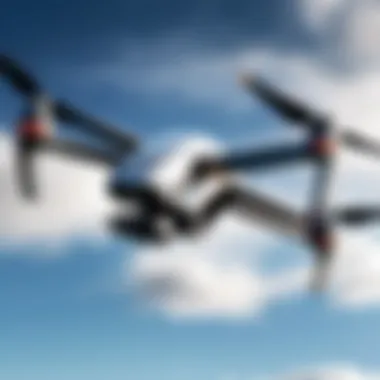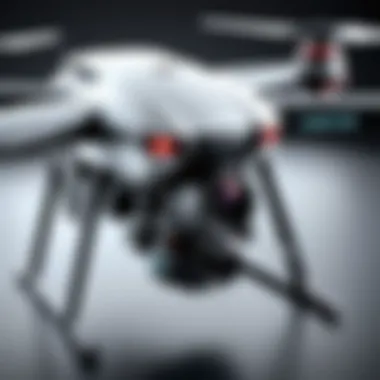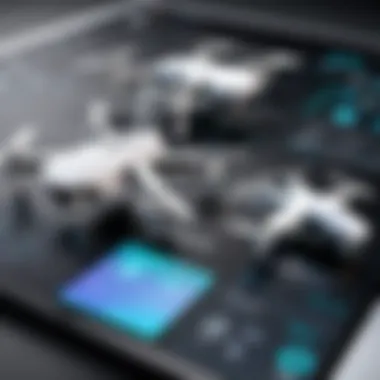Discover Affordable Drones with Cameras for Tech Pros


Intro
The market for low-cost drones equipped with cameras has evolved significantly. As technology advances, it becomes more accessible for both enthusiasts and professionals. Drones that once seemed like luxuries are now within financial reach for many individuals and small businesses. In this article, we will explore the key features, functionalities, and overall value of these budget-friendly drones. We will analyze various models, comparing their performance capabilities and limitations. This information is crucial for IT professionals and tech enthusiasts who are keen to integrate drone technology into their work or personal projects.
Features Overview
Understanding the essential features of low-cost drones is key to making an informed decision. Here, we focus on the crucial specifications and unique selling points that define these devices.
Key Specifications
When looking at low-cost drones with cameras, several specifications stand out:
- Camera Quality: Resolution and frame rate are critical. Many entry-level drones now offer 1080p or even 4K video quality, enhancing image clarity and detail.
- Flight Time: Battery life varies among models, impacting how long you can operate the drone before needing a recharge. Most low-cost drones provide between 15 to 30 minutes of flight time.
- Range: The distance a drone can fly from the controller is essential for various applications. Typical ranges for budget-friendly drones are around 100 to 300 meters.
- Weight: The weight of a drone affects its stability and ease of transport. Light-weight drones are often more portable, making them suitable for on-the-go usage.
Unique Selling Points
The unique selling points of low-cost drones with cameras can set them apart in a crowded market:
- Affordability: These drones offer advanced features at a fraction of the price of high-end models, making them attractive to hobbyists and professionals alike.
- Ease of Use: Many of these drones are designed with user-friendly interfaces and automated flight modes, allowing even beginners to operate them effectively.
- Portability: Lightweight designs make it easy to transport drones, which is ideal for travel or fieldwork.
- Versatility: These drones can serve various purposes, from recreational use to aerial photography and surveying. They prove their value across different industries.
Drones are no longer just toys. They have become practical tools for professional use, offering an innovative way to gather data and capture images from new perspectives.
Performance Analysis
Evaluating the performance of low-cost drones is vital for understanding their capabilities in real-world applications.
Benchmarking Results
In performance tests, low-cost drones often show varying degrees of success. Key performance indicators include:
- Stability: Drones like the Ryze Tello showcase impressive stability even in moderate wind conditions, while some less expensive models may struggle.
- Camera Performance: Notable models, such as the Holy Stone HS720, demonstrate exceptional camera functionality, producing clear images and smooth videos during flight.
Real-world Scenarios
Assessing how these drones perform in practical situations provides valuable insights. For instance, in aerial photography, having a drone with stable flight and good camera quality can significantly impact the quality of images captured.
- Event Coverage: Drones such as the Potensic D80 can effectively capture large-scale events, offering unique perspectives that ground-based cameras cannot.
- Inspection Tasks: Drones are increasingly used in industrial inspections, where high-quality images are necessary to assess structural integrity. Models like the Snaptain SP350 prove useful in such scenarios.
In summary, low-cost drones equipped with cameras are making waves in the market. By understanding their features, unique selling points, and performance metrics, potential buyers can better navigate their options, ensuring a wise investment that meets their needs.
Prelims to Low-Cost Drones
Low-cost drones with cameras have become increasingly relevant in recent years, particularly for IT professionals and tech enthusiasts. As technology improves and prices lower, the landscape of drones has changed significantly. This introduction offers a groundwork for understanding what low-cost drones are and their role in the current market.
Definition of Low-Cost Drones
Low-cost drones are defined as unmanned aerial vehicles (UAVs) that come at an affordable price point while boasting a camera capability. Typically, these drones are accessible to hobbyists and even professionals who seek to leverage aerial imagery without incurring substantial expenses. Prices for such drones often range from a few hundred to around one thousand dollars. At this price, users can still obtain satisfactory photographic and video quality. This balance between affordability and functionality defines the low-cost drone segment, appealing to a range of users—from recreational fliers to novice photographers.
Importance in the Market
The importance of low-cost drones cannot be overstated. They serve as an entry point for many users interested in aerial photography and videography. As user accessibility increases, the demand for these devices has also surged.
- Wider Adoption: Low-cost drones attract a diverse audience, including students, hobbyists, and small businesses, effectively widening the user base.
- Innovation Driver: These drones fuel innovation as manufacturers compete to enhance features while keeping prices low. This competition leads to improved technology and better performance.
- Educational Benefits: Many educational institutions are integrating drone technology into their curricula, teaching students about their applications in various fields like photography, engineering, and environmental science. By utilizing affordable drones, educational programs expand access to this technology without burdening budgets.


In summary, low-cost drones represent a significant advancement in aerial technology. They not only democratize access to aerial photography but also foster innovation and education across diverse sectors. Understanding these elements lays the foundation for exploring specific features, benefits, and challenges associated with low-cost drones equipped with cameras.
Key Features to Look For
When considering the purchase of a low-cost drone equipped with a camera, it is vital to focus on certain key features. These features ultimately determine the drone's usability, performance, and overall value. Partially due to the growing popularity of drones among both hobbyists and professionals, understanding these aspects becomes essential. Failing to appreciate these characteristics could lead to an unsatisfactory buying experience.
Camera Quality and Specifications
The camera quality is arguably one of the most significant factors when selecting a low-cost drone. Generally, a drone with a high-resolution camera can greatly enhance your photos and videos. Look for specifications such as megapixel count, resolutions like 1080p or 4K, and video frame rates. Higher quality cameras capture clearer images and better detail in different lighting conditions.
Also, consider the camera's field of view. A wider view can capture more of the scene, which is advantageous for aerial photography. Features like image stabilization also play an important role, as they minimize motion blur, resulting in smoother video footage. If you are serious about aerial photography, prioritizing these specifications can significantly impact your content production.
Battery Life Considerations
Battery life significantly affects how long you can operate the drone before needing to recharge or replace the battery. Many low-cost drones may have limited flying time, often ranging from 10 to 20 minutes on a single charge. This duration can be extended or shortened based on the drone's weight and the camera being used.
When evaluating battery life, it is also wise to consider the charging time. Quick-charging batteries save time, allowing for more flight sessions. Consider purchasing additional batteries, especially if you plan to use the drone for extended periods. Longer battery life not only increases flying time but also enhances overall user experience.
Range and Connectivity
The drone's range refers to the distance it can fly while remaining connected to the controller. Low-cost drones often have a limited range, which can impact your shooting options. Ranges typically vary between a few hundred meters to several kilometers, depending on the model. Ensure that the drone meets your specific requirements in terms of operational distance.
Connectivity is also essential for smooth operation. Many modern drones utilize Wi-Fi or other real-time connection methods for transferring video and data. Some models offer features like first-person view (FPV) flying, which requires reliable connectivity. An inconsistent connection can lead to interruptions, affecting the quality of the flight experience.
Build Quality and Durability
The build quality of a drone influences its longevity and performance. Low-cost drones may sometimes skimp on materials, making them susceptible to wear and tear. Look for models constructed with sturdy materials like high-grade plastics or reinforced components.
Additionally, consider the weight and design. Lightweight drones are usually easier to control, but they may not handle wind as well as heavier models. Assess the drone's design to ensure it can withstand occasional crashes, which are common with novice flyers. A durable drone not only provides a safer flying experience but also prolongs its lifespan.
Top Low-Cost Drones with Camera
When exploring low-cost drones with cameras, the significance of this topic cannot be overstated. The rapid technological advancements in drone manufacturing have made it possible for budget-friendly options to deliver features that were once exclusive to high-end models. This section will delve into selected low-cost drones, elucidating the benefits they offer to both amateur and professional users.
Low-cost drones provide a vital entry point into aerial photography and videography without demanding substantial financial investment. Potential buyers can now access a range of functionalities, including decent camera quality, stabilization features, and flight duration at a fraction of the price of their more expensive counterparts. These affordable drones empower users to experiment with aerial imagery and gain valuable experience, which may lead to enhanced skills or even professional opportunities.
Considerations when evaluating top low-cost drones include camera specifications, battery life, flight range, and user experience. Knowing these factors can significantly aid in making informed decisions, ensuring that buyers choose models which best suit their needs and expectations.
Model A: Overview and Features
Model A is often recognized as a frontrunner in the budget drone market. Its camera setup boasts a 1080p resolution, allowing for sharp image capture and clear video. Users appreciate the ease of use provided by its intuitive controls, making it suitable for beginners.
Additionally, Model A features an extended battery life of up to 30 minutes, considerably reducing the need for frequent recharging during use. Its compact design enhances portability, appealing to users who require convenience.
Model B: Overview and Features
Model B stands out due to its excellent image stabilization technology. This feature is essential, particularly when capturing video footage, as it minimizes the impact of sudden movements during flight. The drone’s ability to transmit real-time footage back to the pilot through Wi-Fi is a notable advantage, allowing for immediate adjustments if needed.
Further, Model B is equipped with a durable frame, making it resilient to mid-level impacts, a beneficial characteristic for beginner pilots who may encounter mishaps. The overall performance to price ratio puts Model B in high regard in the low-cost category.
Model C: Overview and Features
Model C captures attention with its high-performance camera sensor that provides stunning still images in varying light conditions. This model integrates a user-friendly app that facilitates control and configuration.
The battery life is competitive as well, averaging about 25 minutes per charge, which is adequate for most casual users. Moreover, it includes various flight modes, allowing users to explore creative angles and shots.


Model D: Overview and Features
Model D is best known for its robust range, supporting distances of up to 1,000 meters. Its camera is modest compared to the competition, yet it can still shoot in 720p. This model is particularly suitable for enthusiasts aiming to dive into the world of aerial mapping or surveying.
With advanced features, like follow-me mode and waypoint navigation, Model D appeals to users wanting to experiment with autonomous flying. Despite its limitations, it offers a valuable experience at a manageable price point.
Comparative Analysis of Selected Models
A comprehensive comparative analysis of selected low-cost drones with cameras is vital in discerning which models offer the best value in terms of performance and functionality. This section presents insights into how each model stands against the others, emphasizing factors such as cost-effectiveness, features, and user preferences. Understanding the comparative landscape helps potential buyers make informed decisions tailored to their specific needs.
Price versus Performance
When evaluating low-cost drones, the correlation between price and performance becomes a focal point. Buyers must assess whether the drone's specifications justify its price tag. Models priced similarly can vary significantly in terms of camera quality, battery life, and ease of use.
- Specifications Overview: Consumers often highlight how a lower price point may come at the cost of certain essential features. For instance, some drones may only support 720p recording, while others offer clear 4K videos at the same price.
- Long-Term Value: Choosing the right drone is not only about initial cost but also ongoing costs, including maintenance and potential upgrades. Users should look at how durable the drone is to ensure that it withstands usage over time.
- Performance Analytics: Real-world performance often reveals insights that spec sheets cannot. User reviews frequently indicate issues such as flight stability or connectivity problems that may not emerge during a sales pitch.
User Experiences and Feedback
User experiences and feedback play a crucial role in understanding the real-world functionality of low-cost drones. These narratives provide potential buyers significant insight beyond technical specifications.
- Common Praises: Many users often applaud drones, like the DJI Tello, for their ease of use, excellent camera capabilities, and affordability. Users frequently comment on the joy of aerial photography without requiring extensive flying knowledge.
- Identifying Issues: Conversely, feedback can shed light on common shortcomings. Users of models like the Holy Stone HS720 often mention connectivity issues during outdoor flights, which can be significant depending on user needs. This kind of information is valuable for prospective buyers who may prioritize range and connectivity.
"User feedback is the most honest performance review you can find. It can reveal features that manufacturers might omit and highlight real-world usage scenarios."
- Community Insights: Platforms like Reddit provide a rich source of user discussions. Here, tech enthusiasts share tips, modifications, and troubleshooting advice, creating a community that supports new drone users.
In summary, by closely examining the price versus performance relationship as well as gathering user feedback, potential buyers can arrive at a more informed decision that suits their aerial photography or recreational needs.
Applications of Low-Cost Drones
Low-cost drones have emerged as significant tools in various sectors, blending affordability with functionality. Their usage spans numerous applications, allowing both individuals and organizations to leverage aerial technology without the burden of high costs. This section will delve into some primary areas where low-cost drones excel: aerial photography and videography, recreation and hobbies, and their role in education and training.
Aerial Photography and Videography
Aerial photography has undergone a transformation with the advent of budget-friendly drones. Low-cost models equip users with cameras capable of capturing high-resolution images and videos from unique angles. This capability enhances creative opportunities for photographers and filmmakers.
Key benefits of using low-cost drones for photography include:
- Accessibility: With lower financial barriers, many hobbyists can explore aerial photography without significant investment.
- Versatility: These drones often come with adjustable camera settings, allowing for various shooting styles and conditions.
- Ease of Use: Modern drones incorporate user-friendly interface and often include guided features, making them suitable for beginners.
"The democratization of drone technology is allowing more creatives to pursue projects that were once too costly".
Recreation and Hobbies
Many individuals turn to low-cost drones as a form of recreation and entertainment. Flying drones can be a rewarding experience, offering a sense of freedom and exploration. The hobbyist community around drones is rapidly growing, with clubs and forums enhancing connectivity among enthusiasts. Individuals can enjoy the thrill of piloting their own drone while engaging with a community that shares similar interests.
Considerations in recreational use include:
- Safety and Regulations: Users must understand local laws regarding drone flight to avoid creating risks.
- Skill Development: Operating a drone requires practice, and hobbyists often enjoy improving their piloting skills over time.
- Streaming and Sharing: Many recreational flyers utilize social media platforms like Facebook or Reddit to share their aerial captures and experiences, contributing to a vibrant online community.
Drones in Education and Training
Low-cost drones also play a pivotal role in educational settings. From elementary schools to universities, educators leverage these devices to teach various subjects like technology, engineering, and even environmental science. The hands-on experience facilitates learning through practical application, fostering engagement among students.
Benefits for educational institutions include:


- Interactive Learning: Students can observe concepts in action, such as geography or physics, through real-time applications.
- STEM Initiatives: Incorporating drones encourages interest in Science, Technology, Engineering, and Mathematics, crucial fields for future careers.
- Professional Development: Training programs for teachers about drone integration into the curriculum can equip them with the skills to foster a modern learning environment.
Overall, the applications of low-cost drones are diverse, shaping creative, recreational, and educational landscapes, making them invaluable tools in today's society.
Challenges in the Low-Cost Drone Market
In the landscape of low-cost drones, several challenges need attention. These issues impact design, functionality, and overall user experience. Understanding these challenges is crucial, especially for potential buyers who aim to make informed decisions.
Technical Limitations
Low-cost drones often come with technical limitations that influence their performance capabilities. Many of these drones are built with less advanced materials and components when compared to their higher-priced counterparts. This can lead to issues in reliability, sensor quality, and processing power. For instance, camera resolution may not meet the expectations of users looking for professional-grade photography. Common problems can include:
- Poor Battery Life: Budget drones frequently have shorter flight times, limiting their use to brief periods.
- Limited Range: These drones may struggle with connectivity and range, especially in crowded or remote areas.
- Reduced Stability: In windy conditions, low-cost drones may exhibit instability that impacts the quality of aerial footage.
A thoughtful evaluation of these technical limitations can help users adjust their expectations and align them with the drone's purpose. Factors like intended use, environment, and required features should guide the selection process.
Regulatory Constraints
Regulatory constraints also present significant challenges in the low-cost drone market. Many regions have strict laws governing drone operation, which can affect usage, especially for budget units. Compliance with regulations such as registration, flight altitude restrictions, and geofencing is necessary. Key constraints can include:
- Need for Registration: Some drones, regardless of their cost, must be registered before use. This can be an added step that users may overlook.
- Airspace Limitations: Users often need to navigate complex airspace regulations that vary by location. These restrictions may limit where low-cost drones can operate legally.
- Privacy Laws: Concerns around privacy can lead to increased scrutiny on drone use, deterring users from operating drones in populated areas.
Adhering to these regulations is paramount for safe and responsible drone operation. Understanding the legal landscape can help users avoid penalties and ensure a seamless flying experience. It illustrates the importance of thorough research and consideration before purchasing a low-cost drone.
Future Trends in Drone Technology
As the drone market continues to evolve, it’s essential to understand the emerging technologies that will shape the future of these devices. The advancements in drone technology not only improve the functionalities of low-cost drones but also expand their applicability across various sectors. For IT professionals and tech enthusiasts, staying informed about these trends is vital for leveraging the potential of drones in their respective fields.
Advancements in Camera Technology
One of the most significant trends in the drone industry is the continual improvement in camera technology. High-definition cameras, 4K video capabilities, and even thermal imaging options are now becoming standard features in budget-friendly drones. This shift is essential for various applications, such as aerial photography, surveying, and even search-and-rescue operations.
- Higher Resolution: Many modern low-cost drones now come equipped with cameras that support resolutions of 12 MP or higher. This increase in detail allows for clearer images and more effective data analysis.
- Gimbal Stabilization: The integration of gimbal systems minimizes camera shake, leading to smooth video footage and clearer images. This is particularly necessary for videographers and content creators.
- Smart Features: Functions like object tracking, face detection, and live streaming are being integrated into drones, providing a richer user experience and enhancing versatility.
This progression in camera technology is crucial for users who require high-quality visuals and data collection, enabling them to carry out tasks that were once limited to expensive equipment.
Increased Automation and AI Integration
As drones become more accessible, the integration of automation and artificial intelligence (AI) technologies is transforming how these devices operate. Innovations in AI algorithms allow drones to perform complex tasks without human intervention, offering significant advantages.
- Autonomous Flight Modes: Drones are increasingly featuring autonomous capabilities allowing them to navigate pre-set flight paths and avoid obstacles. This improves safety and ease of operation for users.
- Data Analysis and Processing: AI can enhance data collection and analysis, enabling drones to provide real-time insights. This is particularly relevant in sectors like agriculture, where drone data can inform crop health monitoring.
- Machine Learning: The ability of drones to learn from their environment increases their adaptability. They can optimize performance based on previous flights, adjusting to variables like weather and terrain.
These advancements lead to more efficient drone operations, reducing the need for manual control and enabling users to focus on strategic aspects of their tasks. Automation and AI will undoubtedly shape the future landscape of low-cost drones, making them valuable tools across diverse fields.
"The integration of AI in drone technology marks a paradigm shift, paving the way for smarter, more efficient operations in various industries."
Finale and Key Takeaways
In the rapidly evolving landscape of drone technology, the exploration of low-cost drones with cameras emerges as a particularly crucial topic for IT professionals and tech enthusiasts. Understanding the essential aspects of these devices can significantly enhance user decision-making processes, ensuring a valuable investment.
Throughout this article, we have detailed various facets of low-cost drones, addressing their defining characteristics and the context of their rise in the market. The importance of pinpointing key features such as camera quality, battery life, and build durability cannot be understated. Consolidating this knowledge allows users to judiciously navigate their options, aligning their needs with the right specifications.
Moreover, the comparative analysis provided insights into performance and user feedback, guiding readers to understand how different models stack up against each other. This empirical evaluation aids potential buyers to discern value beyond mere price tags. Choices made in haste can lead to dissatisfaction when expected functionalities do not meet reality.
As noted in the applications of low-cost drones, the versatility of these devices enriches areas such as aerial photography, recreational use, and even educational purposes. By synthesizing the information offered, readers can appreciate the broader implications of integrating drones into multiple facets of life and work.
Furthermore, challenges in the market remind users to remain aware of the technical constraints and regulatory issues that can affect drone operation. Keeping abreast of these factors ensures informed decisions that take into account potential hurdles.
Lastly, looking towards future trends in drone technology, innovations in camera capabilities and automation will continue to redefine user experiences, creating even greater advancements in utility and functionality. The discussed elements in this article yield a comprehensive overview that not only simplifies the buying process but also elevates user knowledge and preparedness.
In summary, engaging with low-cost drones equipped with cameras is not just about seeking budget-friendly options; it involves a thoughtful approach to evaluating features, understanding market dynamics, and anticipating future changes in technology. By weighing these considerations, readers will be better equipped to make sound choices that resonate with their specific interests and requirements.



